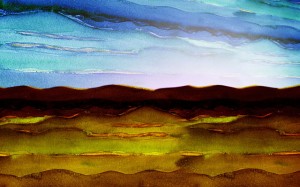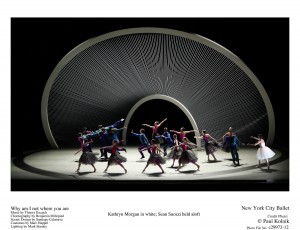As an art form, dance is a mixture of the visual and the auditory. While we watch dancers perform aesthetic pieces onstage, we hear music meant to enhance the experience. Because of this inclusive nature of dance, collaborations among designers, musicians, and choreographers are commonplace and have been for some time, allowing for artists in their respective fields to showcase their talent alongside each other. In 1913, Nijinsky and Stravinsky brought audiences the ballet, The Rite of Spring before a set by the designer Roerich. Picasso designed the scenery and costumes for Cocteau’s ballet Parade in 1917, which was set to music by Satie. And closer to home, Merce Cunningham initiated a number of creative and fruitful partnerships. He worked with musicians such as John Cage, Sonic Youth, Sigur Rós and Radiohead, and visual artists like Robert Rauschenberg, Jasper Johns, and Olafur Eliasson. Though he hasn’t worked with a dance company yet, William Kentridge, who was featured in Art:21 Season 5, has designed sets for productions of The Magic Flute and The Nose.
The New York City Ballet is presenting the latest dance-art relationship, offering what could be described as a gesamtkunstwerk, the Wagnerian term for a total work of art. Their Spring 2010 season features an extensive listing of artistic collaborations among instrumental music, dance choreography, and the visual arts. Among the new commissions are four original scores and seven new ballets, five of which are to be performed against backdrops designed by renowned Spanish architect and artist Santiago Calatrava. It is appropriately called The Architecture of Dance. Commissioning scenery from an architect is an interesting choice on the part of the Ballet and must have been an exciting challenge for Calatrava. While sets change throughout a short work of dance, buildings and bridges — Calatrava’s usual fare — are meant to last.
Calavatra is known for designing light-filled, airy buildings. Best known in this country for his expansion to the Milwaukee Art Museum, he has designed prolifically in Europe, bringing France the Lyon Airport Station, and Spain the Alamillo Bridge in Seville. In 2014, his World Trade Center Transportation Hub is scheduled to open in lower Manhattan. Calatrava is also an artist and a sculptor; the Metropolitan Museum of Art recently staged Santiago Calatrava: Sculpture into Architecture, an exhibit showing how many of his signature buildings began as sculptures.
Over at Lincoln Center, I went to see Melissa Barak’s new work, Call Me Ben, about the 1940s gangster Ben “Bugsy” Siegel, who built the first luxury hotel in Las Vegas. The New York City Ballet commissioned Barak’s choreography to accompany a commissioned score by Jay Greenberg. Gilles Mendel designed the glamorous costumes. The scenery Calatrava designed for Call Me Ben is simple and painterly, relying on palm trees and golden-hued mountains to evoke the American West. The other Calatrava sets for this project are a mix of painted backdrops and sleek geometric designs.
A collaboration such as this highlights the close-knit nature of the greater art world and the possibility for artists in any field to think outside the box and explore new modes of creativity. Bringing in a visual artist to work on a ballet project reminds those of us in the fine art world to view dance as a visual art form. Instead of using paint and canvas, dance relies on its dancers’ bodies to make shapes and forms on the stage. These are sometimes more literal, telling a clear story, and sometimes abstract. The increase in the popularity and visibility of performance art (more on this in a later post) certainly helps bridge the dance-art/architecture gap. Hopefully we will see more contemporary artists teaming up with visionaries from other artistic fields to bring us more exciting and thoughtful pieces.







Pingback: New York City Ballet: Architecture of Dance « FXFOWLE Blog
Pingback: BAILA – A Latin Dance Party | zumba training workout